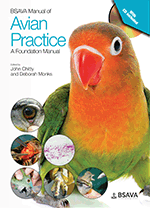
Full text loading...

The class of Aves is vastly diverse, with over 10,000 species in 27 different orders. The anatomy and physiology described within this chapter is based on that of parrots, raptors, passerines, pigeons and chickens. Various interesting variations seen in species of other orders are also described.
Anatomy and physiology, Page 1 of 1
< Previous page | Next page > /docserver/preview/fulltext/10.22233/9781910443323/9781910443323.2-1.gif

Full text loading...






















